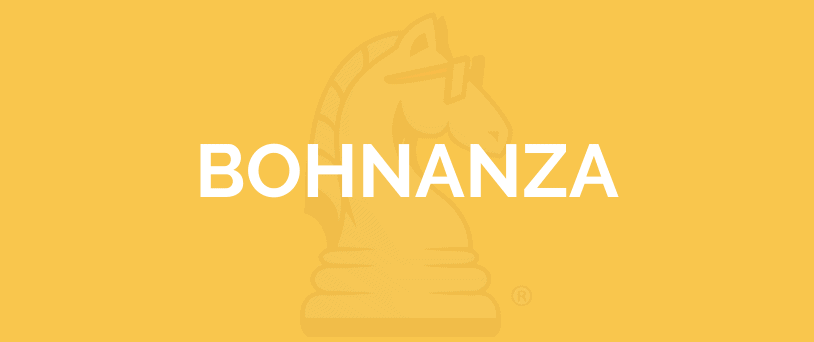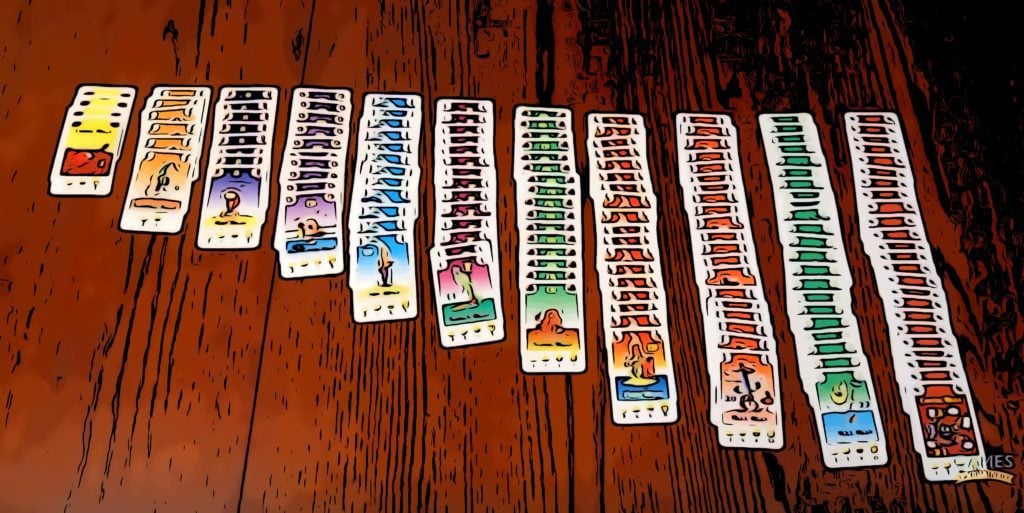
OBJECTIVE OF BOHNANZA: The goal is to be the player with the most coins at the end of the game.
NUMBER OF PLAYERS: 2-7 players
MATERIALS: 154 bean cards of varying sets, Seven 3rd bean field cards, 1 rule book
TYPE OF GAME: Competitive/Cooperative Trading Resource Game
AUDIENCE: For all people ages 13 and up
OVERVIEW OF BOHNANZA
In Bohnanza players will plant, harvest and sell beans trying to profit as much as possible as they do so. The goal of the game is to have the most gold at the end and be the best bean farmer at the table. This game is all about supply and demand and trading for the most profit.

SETUP
The 3rd bean field cards are left in the box and all remaining valid cards are shuffled. (some bean types are omitted based on player number). Five cards are dealt randomly to each player face-down and the remaining bean cards are placed gold coin side up in the center of the table for the draw deck.
Each player may now pick up their hand but do not change the order of the cards! The way your hand is organized will remain the same for the whole game. Players will decide now which side they will plant cards from and which side they will add cards to. The player left of the dealer starts the game.
GAMEPLAY
There are four phases to a player’s turn they are planting beans, draw, trading and donating beans, plant donated and traded beans, and draw new bean cards. Each phase must be completed before continuing to the next.
Planting Beans
The player must plant the first bean card in their hands into one of their fields. If it matches any of the beans, they currently have planted they may add it to that field, or if the player has an empty bean field it may be added there as well. If the player does not have an empty bean field or the bean does not match any of their current beans they must uproot and sell their beans even if they will receive no gold. A bean field with only one bean may not be uprooted unless all fields only have one bean.
After the first bean is planted a player may choose to plant their second bean in hand or not. If the player chooses to, they will follow the same requirements as the first bean. Two is the max number of beans allowed to be planted in this phase. If a player has no beans in hand skip this phase.
Draw, Trade and Donate Beans
After planting your initial beans, you will draw the two most top cards on the bean deck and lay them face-up on the table for everyone to see. You may keep and plant these cards, trade them or donate them to other players. You cannot add them to your hand, any bean acquired during this phase whether drawn, traded or donated must be planted.
After the two drawn cards are dealt with, the active player may start trading or donating beans from their hand. Other players are also allowed to initiate trades or donations but only if they involve the active player.
On the subject of donating beans, a player may freely give away beans to other players, but the other player does not have to accept it. If the bean is not accepted the trade does not go through and the original bean hold still owns that bean. You may decide to donate beans if no good trades are available and you0 do not wish to plant the bean on your turn.
Planting Donated and Traded Beans
Once all trades have been finalized, any bean acquired by the active or non-active players must be planted. You can plant beans in any order, but they must all be planted. If you do not have an open bean field for an unmatched bean you must harvest and sell a bean field or buy a third bean field (only one 3rd bean field per player).
Draw New Bean Cards
To end your turn, you will draw three cards one at a time from the bean deck. These cards will be added in the order drawn to the back of your hand. If the draw deck is empty when you attempt to draw reshuffle the discard pile and continue drawing.
SELLING HARVESTED BEANS
Beans may be harvested and sold at any time during the game, even outside of your turn. To harvest you must collect all beans of the same type from their bean field and count them. Looking on the bean card at the bottom it will tell you how much gold you receive from how many beans sold; flip the appropriate number of bean cards over to their gold side and place them near you and the remaining bean cards go to the discard pile.
It is possible to get no gold from selling beans, and when selling beans, you may only sell from fields containing two or more beans. This is true unless you only have fields with one bean in them, then you may sell from either.
Third Bean Fields
Third bean field allows players to plant a third row of beans. It can be purchased for three gold and used immediately. Third bean fields can be purchased at any time in the game.
To buy it you must take the three topmost gold from your gold pile and discard them face down in the discard pile, you will then receive a third bean field card.
ENDING THE GAME
The game ends when the draw deck has been emptied for the third time. If this happens in phase two phase three may be completed and then the game ends. If a player cannot draw two cards in phase 2, they may just draw one.
All players will then set aside their hands and harvest their fields. Gold is then counted and the player with the most is the winner. In the case of a tie the player amongst those with the most gold who has the most cards in their remaining hand is the winner.
GAME VARIATIONS
- 3 players: Cocoa beans are removed; each player starts the game with a third bean field, another may not be purchased; the game ends after the deck is emptied a 2nd time.
- 4-5 players: Coffee beans are removed from the game.
- 6-7 players: Cocoa and garden beans are removed; Starting hands are dealt 3 to the first player, 4 to the second, 5 to the third and 6 cards to the remaining players; during phase 4 four cards are drawn by the active player instead of three; to buy a third bean field it only cost 2 gold.
- Comprehensive Guide to the Board Game Go (weiqi, baduk) - January 23, 2024
- Are Creative Suites Changing Gaming - October 30, 2023
- How Classic Games Have Been Reimagined for Modern Audiences - October 5, 2023